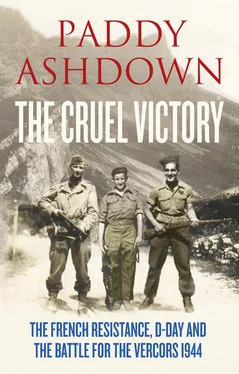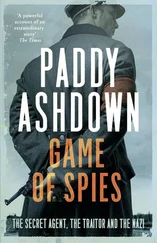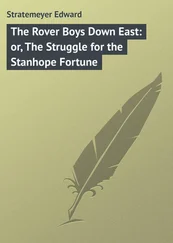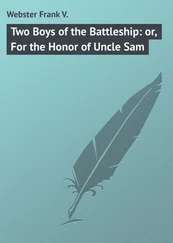The Romans came this way fifty years before the birth of Christ. Pliny, writing in AD 50, referred to the people of the plateau as the Vertacomacori, a word whose first syllable may have been carried forward into the name ‘Vercors’ itself. Eight centuries later, the Saracens followed the Romans, implanting themselves in Grenoble for some years. According to local legend, they even sent a raiding party towards the Pas de la Balme on the eastern wall of the plateau, but were beaten back by local inhabitants rolling rocks down on the invaders. Less than a hundred years later, towards the end of the tenth century, the Vikings came here too, but from the opposite direction – south down the Rhône in their longships. And 400 years after that, the Burgundian armies followed them on their own campaign of conquest and pillage. Then in March 1815, Napoleon, after landing on the Mediterranean coast from Elba, marched his growing army north along the route which still bears his name under the eastern flank of the Vercors, towards Grenoble, Paris and his nemesis at Waterloo.
Napoleon excepted, what is most significant about these invaders is that, though there are signs enough of their passing in the countryside below, there are few on the Vercors itself. It is as though these foreigners were content to pass by in the valleys without wishing to pay much attention to the cold, poverty-stricken and inhospitable land towering above them. One consequence of this passage of armies and occupiers is, however, more permanent. The historian Jules Michelet, writing in 1861, commented: ‘There is a vigorous spirit of resistance which marks these provinces. This can be awkward from time to time; but it is our defence against foreigners.’
The plateau itself is shaped like a huge north-pointing arrowhead some 50 kilometres long and 20 wide. It covers, in all, 400,000 hectares, about the same size as the Isle of Wight. An Englishman who will play a small part in this history described it, in his prosaic Anglo-Saxon way, as a great aircraft-carrier steaming north from the middle of France towards the English Channel.
This extraordinary geological feature is the product of the the shrinking earth and the faraway press of the African continent, whose northward push against the European mainland generates the colossal pressures which wrinkle up the Alps and squeeze the Vercors limestone massif straight up in vertical cliffs, 1,000 metres above the surrounding plain.
Map 1
No concessions are found here to accommodate the needs of man. The Vercors offers nothing in the way of easy living. Extreme difficulty of access made the plateau one of the poorest areas, not just of France, but of all Europe, until new roads were blasted up the cliff faces in the nineteenth century. The forbidding bastion of the eastern wall of the plateau, stretching from Grenoble to the plateau’s southern extremity, is accessible only by goats, sheep and intrepid walkers. For vehicles, there are just eight points of access to the plateau, one on its southern flank, five spread out along its western wall and two on its north-eastern quarter. Of these, all bar one involve either deep gorges into which the sun hardly ever penetrates or roads which rise dizzily through a tracery of hairpin bends to run along narrow ledges and through dark tunnels blasted from vertical rock faces.
Only the road on the plateau’s north-eastern edge offers something different. Here the slope rises placidly from the back gardens of the Grenoble suburbs and is served by a moderately engineered road, supplemented, until 1951, by a small funicular tramway, at the top of which is the little town of Saint-Nizier. This sits on its own natural viewing platform, looking out over the city to the mountain-flanked valley of the Isère (known as the Grésivaudan valley) and the white mass of Mont Blanc in the distance.
The Vercors plateau itself is dominated by three rolling ridges which run along its length from north to south like ocean breakers. Their tops are above the treeline, rock-strewn and so sparsely covered with mountain grasses that on bright summer days the white from the limestone below seems to shimmer through the thin air and dazzle the eyes. In some high, very exposed areas, where the hot summer winds have whipped off all the soil, the limestone rock is laid bare and fissured into deep cracks, some large enough for a man – or several men – to stand up in. These are wild and terrible places, known to the locals as lapiaz . Their only gentleness lies in the strange lichens and alpine plants which make their homes in the cracks and survive by straining moisture from the dew-laden air of summer mornings.
Further down, there are cool conifers and one of the largest stands of hardwood in western Europe. Further down still, cradled in the valleys, are the little towns, villages and hamlets of the Vercors community – many of them, such as Saint-Martin, Saint-Julien, Saint-Agnan, La Chapelle, speaking of a past where an attachment to the right God was as important to survival as skill at animal husbandry and knowing the right time to plant the crops. Here, though the bitter snow-filled winters remain tough, there is good grazing and comfortable summer living.
One essential ingredient of life, however, is not easily available – water. This is a limestone plateau and every drop that falls as rain or seeps away from melting snow drops down through the limestone into hidden channels, underground rivers and a still-undiscovered network of chambers and caverns which honeycomb the whole Vercors plateau. Some say a drop of moisture captured in a snowflake which falls on the summit of the plateau’s highest peak, the 2,341-metre Grand Veymont, will take three years to pass in darkness through the hidden channels under the mountains before it sees the light of day again, tumbling down through the plateau’s gorges on its way to the Rhône and the warm waters of the Mediterranean far away to the south. Surface water across the whole plateau is rare and wells and springs even more so. All of them are widely known and meticulously marked on every Vercors map.
This is the unique topography and meteorology which has played such an important part in shaping both the Vercors, and the lives of those who have struggled to live and take refuge there, not least during the years of France’s agony in the Second World War.
But it is not just the topography that makes the Vercors unique. The plateau lies at the precise administrative, architectural, cultural and meteorological dividing line between northern, temperate, Atlantic France and that part of France – Provence – which looks south to the Mediterranean. The frontier between the departments of the Isère and of the Drôme divides the plateau into two halves: the northern Vercors is in the Isère and the southern Vercors is in the Drôme.
At least until the Second World War, these two Vercors were quite different. Indeed, as late as the nineteenth century, the rural folk of the plateau spoke two different and mutually incomprehensible languages, the langue d’oc and the langue d’oïl . The northern Vercors took its lead from sophisticated Grenoble. Here, at Villard-de-Lans, was established one of the first – and one of the most fashionable – Alpine resorts in France, frequented in the 1930s by film stars, the fashionable, the sportif and the nouveau glitterati of Paris. During pre-war summers, the area became one of the favourite Alpine playgrounds for those with a passion for healthy and sporty living; it teemed with hikers, climbers, bikers and even practitioners of Robert Baden-Powell’s new invention from England, le scouting . The southern Vercors on the other hand – the ‘true Vercors’ according to its inhabitants – remained virtually unchanged: still agricultural, still largely isolated, still taking its lead more from Provence and the south than the styles and sophistications of Paris and the north.
Читать дальше












